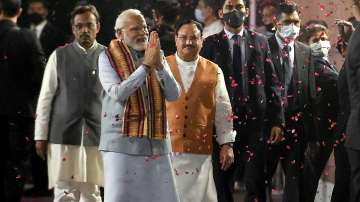The BJP's victory in the assembly polls has put the party on a stronger wicket for the election for the post of President expected later this year. The big victory for the BJP in Uttar Pradesh has given Prime Minister Narendra Modi a free hand to decide on the successor to President Ram Nath Kovind, who will complete his tenure on July 24, 2022.
The electoral college for the presidential election comprises elected members of Lok Sabha, Rajya Sabha and elected members of state legislative assemblies and that of NCT Delhi and Union Territory of Puducherry. Members of Legislative Councils and nominated members do not form part of the electoral college. Among all, Uttar Pradesh has the highest value of votes in the electoral college.
Though the BJP-led NDA doesn’t have a majority in the Rajya Sabha, the alliance is now clearly on a strong wicket with the latest wins, giving its presidential candidate an edge. By the end of 2022, the BJP will be able to cross 100 seats for the first time in the 243-chair House. The party will have 104 members in the Upper House. Currently, it has 97 members.
The party will gain three Rajya Sabha seats in Uttar Pradesh and take away four seats from the Congress in Assam, Himachal Pradesh and Uttarakhand this year. Accordingly, the NDA's strength will also go beyond 120.
Had the Uttar Pradesh election results gone in favour of the Samajwadi Party, the BJP would have had to rely on the support of fence-sitters such as Biju Janata Dal (BJD), Telangana Rashtra Samithi (TRS), YSR Congress Party (YSRCP) who together control a sizeable chunk of votes.
In terms of numbers, the electoral college is made up of 233 members of Rajya Sabha, 543 members of Lok Sabha and 4,120 members of legislative assemblies - a total of 4,896 electors. The value of the vote of every MP has been fixed at 708, while among states the value of the vote of an MLA is the highest at 208. Accordingly, the total value of votes of the Uttar Pradesh assembly is 83,824, Punjab (13,572), Uttarakhand (4480), Goa (800) and Manipur (1080).
The presidential elections follow the system of proportional representation by means of a single transferable vote. The value of each vote is pre-determined in proportion to the population of the respective state based on the 1971 census.
The total value of the electoral college, comprising 4,896 electors is 10,98,903 and the winning candidate has to get at least 50 per cent plus one vote to be declared as elected.
READ MORE: AAP on course of becoming 5th largest party in Rajya Sabha - Explained
Latest India News
